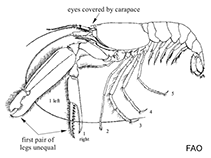Malacostraca |
Decapoda |
Alpheidae
Environment: milieu / climate zone / depth range / distribution range
Ecology
Benthic. Tropical
Western Central Pacific: Philippines.
Length at first maturity / Size / Weight / Age
Maturity: Lm ? range ? - ? cm
Body not particularly slender or stout, carapace and abdomen slightly compressed laterally, glabrous. Carapace with inconspicuous suture proximal to base of antenna. Frontal margin protruding and broadly rounded, without rostral projection or orbital teeth, without orbital crests. Pterygostomial angle rounded; branchiostegial region with pronounced "lip" anteriorly; cardiac notch fairly deep. Eyes not visible in dorsal view; anteromesial process feebly marked; cornea small, lateral, pigmented. Ocellar beak not conspicuous.
Antennular peduncle relatively stout, flattened dorsoventrally; second segment about twice as long as broad, about as long as dorsally visible portion of first segment; stylocerite not reaching distal margin of first segment, subacute distally; ventromesial carina of first segment with strong tooth; lateral flagellum biramous, with shorter ramus well developed, situated at third segment. Antenna with basicerite bearing strong ventrolateral tooth; scaphocerite broadly ovate, anterior margin of blade convex but not protruding beyond distolateral tooth; carpocerite long, stout reaching far beyond scaphocerite.
Chelipeds strongly asymmetrical in shape, unequal in size, carried folded when not in use. Major cheliped (on either left or right side) enlarged, elongate; ischium short, ventromesial margin without subtriangular tooth; merus long, slender, with smooth margins, distally not widening, ventrally flattened, distally more depressed, distal margin with blunt lobes; carpus short, cup-shaped, with blunt distal process; chela subcylindrical, palm smooth, ventromesially excavated, about 2.5 times as long as high; adhesive discs well developed; fingers about 1/3 length of palm; dactylus moderately curved distally, with subacute tip, cutting edge with one median subtriangular-rounded tooth, about 1/2 as high as long, without proximal tooth; pollex shorter than dactylus, abruptly ending, with one blunt terminal tooth, cutting edge with two teeth: one much larger subtriangular proximal tooth and one smaller truncate distal tooth. Minor cheliped shorter and weaker than major cheliped; ischium short, unarmed; merus slender, ventrally depressed; carpus very short, cup-shaped; chela smooth, subcylindrical, with fingers about 1.2 times as long as palm, tips crossing when chela closed; cutting edges of dactylus and pollex with small curved teeth proximally and two larger opposing teeth at about mid-length.
Second pereiopod slender; ischium about 3/4 length of merus; carpus five-segmented, segments with ratio approximately equal to: 4/1/1/1/2.5; chela simple, about as long as first carpal segment; fingers as long as palm. Third pereiopod moderately slender; ischium unarmed; merus flattened mesially, about 2.5 times as long as ischium, about five times as long as wide; carpus less than 1/2 length of merus, with distoventral spiniform seta; propodus longer than carpus, with three ventral spiniform setae and one distoventral spiniform seta proximal to dactylus; dactylus simple, conical, about 2/5 length of propodus, curved. Fourth pereiopod generally similar to third. Fifth pereiopod much more slender than third and fourth pereiopods; ischium and merus not flattened mesially, unarmed; carpus without distal spiniform seta; propodus as long as merus, without spiniform setae, distally with at least seven rows of setae; dactylus similar to that of third and fourth pereiopods.
First to fifth pleomeres with minute pits on surface; posteroventral angles rounded; sixth pleonite with large articulated plate posteroventrally. First pleopod with very short endopod, latter fringed with setae apically. Male second pleopod with appendix interna and appendix masculina, latter almost twice as long as former, and bearing numerous slender, spiniform apical and subapical setae.
Uropod with lateral lobe of protopod bearing two small acute teeth distally; endopod somewhat longer than exopod, without specific features; exopod with truncate posterior margin and without distinct distolateral tooth adjacent to distolateral spine; lateral portion of diaeresis straight , not curved into tooth centrally; mesial portion deeply incised forming large triangular tooth proximal to mesial margin.
Telson moderately slender, more than twice as long as wide proximally; dorsal surface pitted, with two pairs of robust spiniform setae inserted at short distance from lateral margin, at about 1/3 and 2/3 length of telson, respectively; posterior margin feebly rounded, posterolateral angles each with pair of spiniform setae, mesial at least four times as long as lateral; anal tubercles small, feebly sclerotised.
Found in burrows of Glypturus cf. armatus together with gastropods (i.e., Phenacolepadidae) and sentinel crabs (i.e., Macrophthalmus sp.) (Ref. 81110).
Life cycle and mating behavior
Maturity | Reproduction | Spawning | Eggs | Fecundity | Larvae
Members of the order Decapoda are mostly gonochoric. Mating behavior: Precopulatory courtship ritual is common (through olfactory and tactile cues); usually indirect sperm transfer.
Anker, A. and I.N. Marin 2009 The alpheid shrimp genus Leptalpheus Williams, 1965, in the tropical Western Pacific, with descriptions of two new species (Crustacea: Decapoda: Caridea). The Raffles Bulletin of Zoology 57(1):91-107. (Ref. 81110)
IUCN Red List Status
(Ref. 130435: Version 2025-1)
CITES status (Ref. 108899)
Not Evaluated
Not Evaluated
Threat to humans
Harmless
Human uses
| FishSource |
Tools
More information
Trophic EcologyFood items (preys)
Diet composition
Food consumption
Predators
Population dynamicsGrowth
Max. ages / sizes
Length-weight rel.
Length-length rel.
Length-frequencies
Mass conversion
Abundance
Life cycleReproductionMaturityFecunditySpawningEggsEgg developmentLarvae PhysiologyOxygen consumption
Human RelatedStamps, coins, misc.
Internet sources
Estimates based on models



